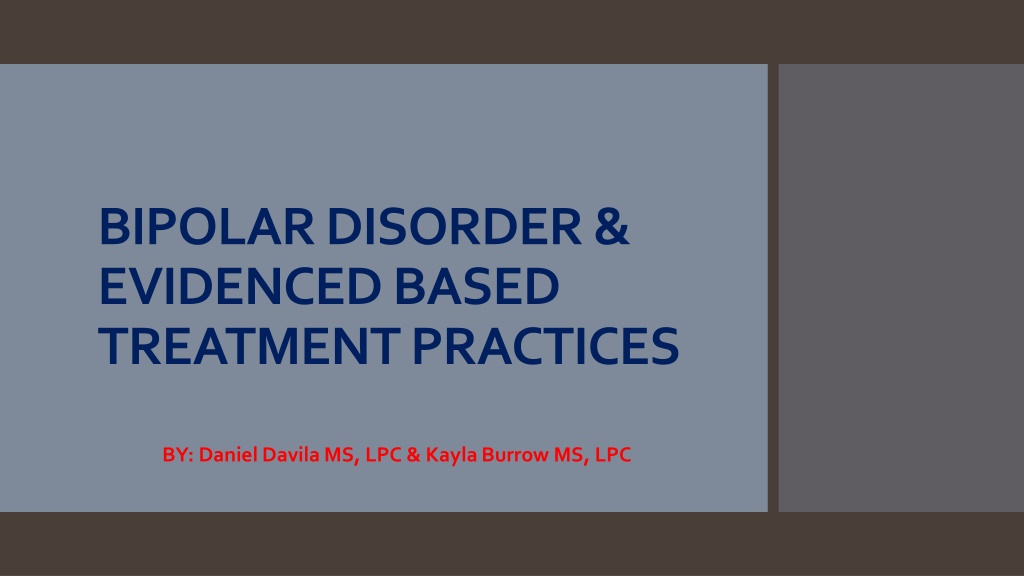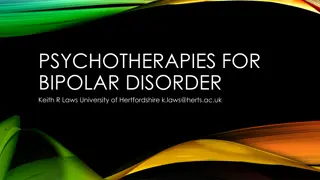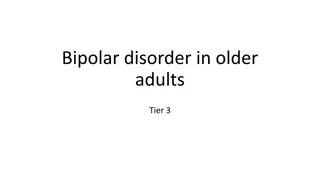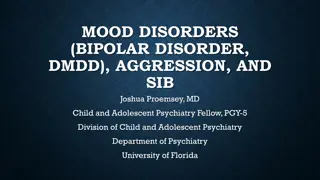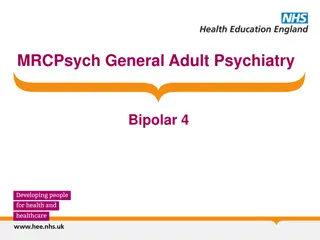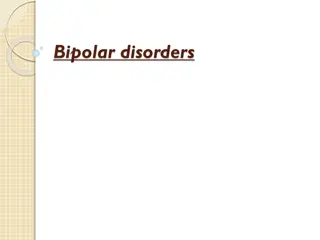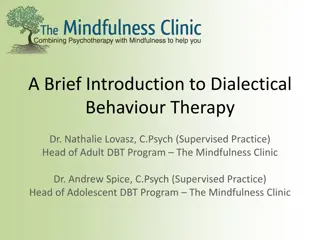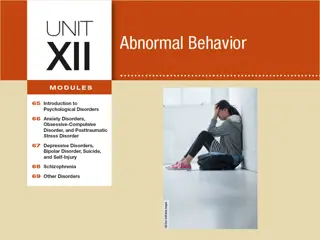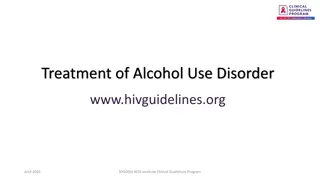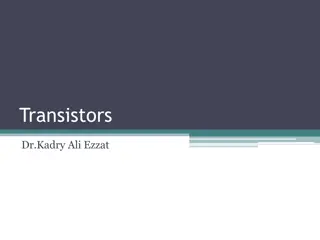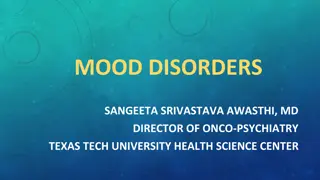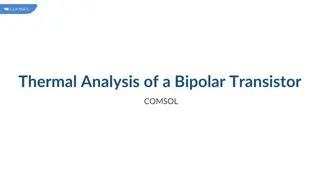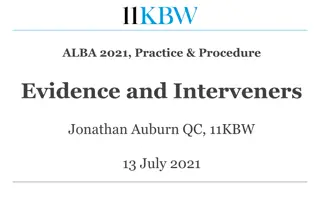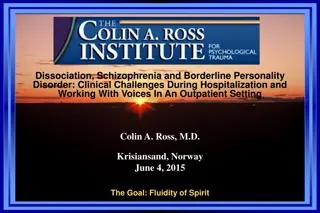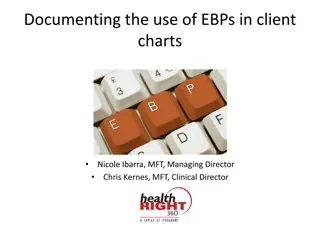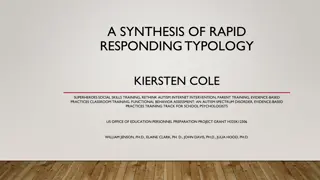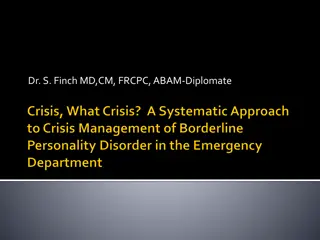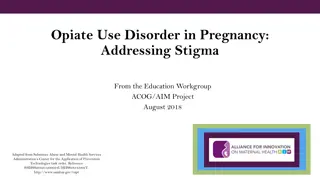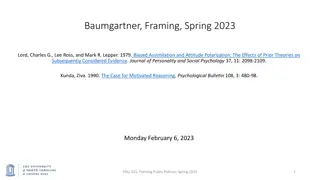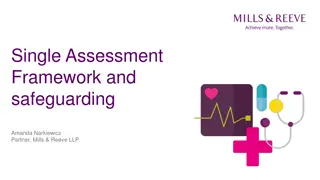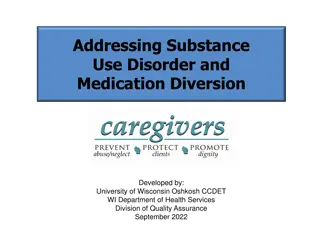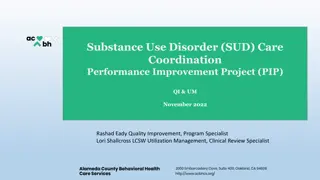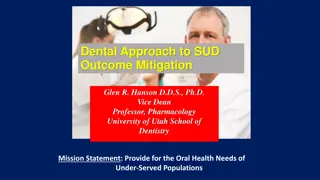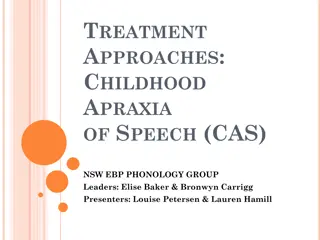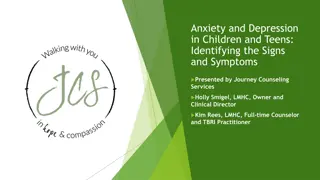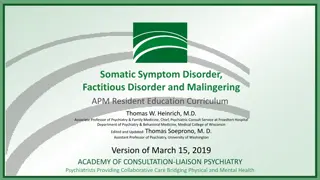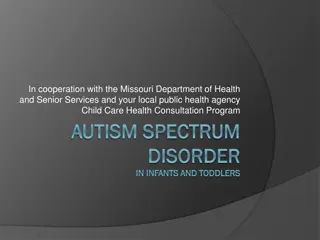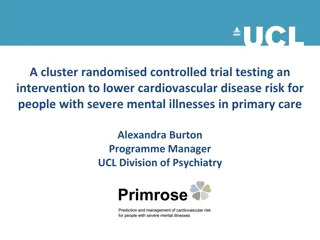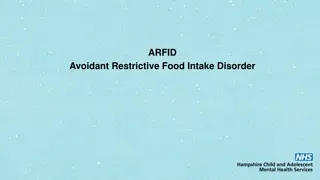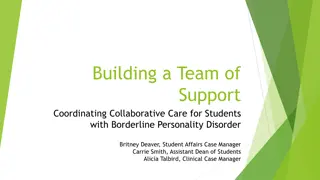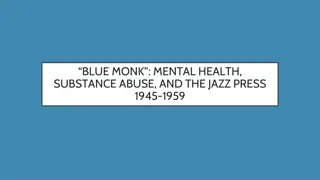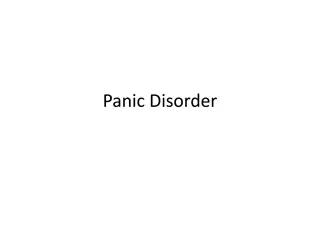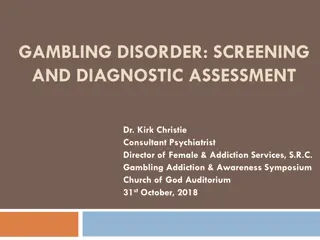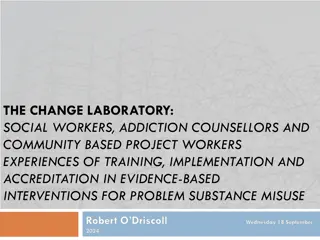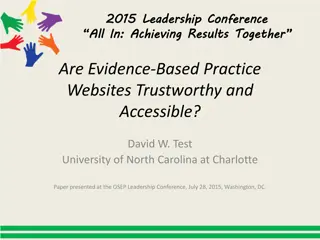Understanding Bipolar Disorder and Evidence-Based Treatment Practices
This presentation by Daniel Davila, MS, LPC, and Kayla Burrow, MS, LPC delves into the complexities of bipolar disorder, potential crisis outcomes, and mental illness management through evidenced-based treatment practices. Topics covered include bipolar diagnosis, assessing disorder lethality, treatment options, and outcomes. The speakers, experienced in crisis intervention and assessment services, aim to equip individuals personally affected by bipolar disorder or professionals dealing with it with knowledge and resources for effective management and recovery.
Uploaded on Sep 27, 2024 | 0 Views
Download Presentation

Please find below an Image/Link to download the presentation.
The content on the website is provided AS IS for your information and personal use only. It may not be sold, licensed, or shared on other websites without obtaining consent from the author. Download presentation by click this link. If you encounter any issues during the download, it is possible that the publisher has removed the file from their server.
E N D
Presentation Transcript
BIPOLAR DISORDER & EVIDENCED BASED TREATMENT PRACTICES BY: Daniel Davila MS, LPC & Kayla Burrow MS, LPC
The presentation will discuss topics related to bipolar disorder, potential crisis outcomes due to bipolar, and mental illness as it can relate to both topics at hand. Our goal is to provide you with both knowledge and resources on how to proceed should you be affected by this rather personally or as a professional providing an assessment service to someone in need. DISCLAIMER If you are feeling overwhelmed or uncomfortable during the presentation, please feel free to remove yourself take a break or ask for help. We will be available to process with you during breaks or after the presentation.
1. Understanding Bipolar Diagnosis 2. Assessing Bipolar Disorder and Potential Lethality LEARNING OBJECTIVES 3. Utilizing Evidenced Based Practices as Treatment Options Illness Management Recovery 4. Treatment Outcomes
Daniel Davila, MS, LPC Kayla E. Burrow, MS, LPC Supervisor of MCOT, MCOT Expansion, & MCOT Walk in Crisis Clinic Supervisor of CIT & Clinical Coordinator of Pathways (Crisis Respite Center) Respond in Community and to Walk Ins within Our Center for Face to Face Crisis Intervention/Assessment Supervisor of Crisis Intervention Team Clinical Oversight of Pathways Crisis Respite Center Work in Conjunction with the Crisis Hotline/AVAIL, CCPD, & Other Internal Programs to provide Crisis Intervention/Assessment Respond to CCPD dispatch and Officer calls requesting crisis assessment and intervention for mental health crisis in the Community WHO ARE WE & WHAT DO WE DO? Assess, Evaluate, & Stabilize through least restrictive means, only recommending hospitalization if individual is an imminent danger to self or others Partners with law enforcement to divert from arrest and hospitalization when possible Provide crisis intervention through an assessment, utilize least restrictive environment (hospital, Crisis Respite Unit, Crisis walk in clinic, etc) Outpatient Psychiatric Care Link & Refer to Community & Agency Resources Obtaining mental health warrants for hospitalization when necessary to ensure safety Coordinate with CIT for CenikorAdmissions Crisis Follow Up & Prevention Direct admission to Cenikor (Substance Use Treatment) Case Management Transitional Services Crisis follow up & prevention Pharmacological Management & Education Case Management MCOT is available 7 days per week, 24 hours per day Transitional Services Pharmacological Management & Education MCOT Walk in Crisis Clinic is available Mon Fri, 8a 4p
Bipolar Disorder I Bipolar II BIPOLAR DISORDER I & II 1 major depressive episode and 1 hypomanic episode, but have not experienced mania 1 manic episode that is preceded or followed by hypomania or depression.
Bipolar Mania Bipolar disorder, formerly called manic depression, is a mental health condition that causes extreme mood swings that include emotional highs (mania or hypomania) and lows (depression). When you become depressed, you may feel sad or hopeless and lose interest or pleasure in most activities. When your mood shifts to mania or hypomania (less extreme than mania), you may feel euphoric, full of energy or unusually irritable. These mood swings can affect sleep, energy, activity, judgment, behavior and the ability to think clearly. Episodes of mood swings may occur rarely or multiple times a year. While most people will experience some emotional symptoms between episodes, some may not experience any. Mood in a manic episode is often described as euphoric, excessively cheerful, , high, or feeling on top of the world. In some cases, the mood is of such a highly infectious quality that it is easily recognized as excessive and may be characterized by unlimited and haphazard enthusiasm for interpersonal, sexual, or occupational interactions. (For example, the individual may spontaneously start extensive conversations with strangers in public. Often the predominant mood is irritable rather than elevated, particularly when the individual s wishes are denied or if the individual has been using substances. Rapid shifts in the mood over brief periods of time may occur and are referred to as lability (i.e., the alternation among euphoria, dysphoria, and irritability). Overview of Bipolar Disorder DSM V pg. 128 https://www.mayoclinic.org/diseases-conditions/bipolar- disorder/symptoms-causes/syc-20355955
Individual may engage in multiple overlapping new projects Inflated self-esteem Grandiose delusions Decreased need for sleep Speech can be rapid, pressured, loud, and difficult to interrupt Often the individual s thoughts race at a rate faster than they can be expressed through speech. Flight of ideas, disorganized speech, incoherent Distractibility; inability to hold rational conversation or attend to instructions Increase in goal-directed activity often consists of excessive planning and participation in multiple activities, including sexual, occupational, political, or religious activities. Increased sexual drive, fantasies, sociability, increased psychomotor agitation/restlessness. Features of Mania (cont d) DSM V
Expansive mood, excessive optimism, grandiosity, and poor judgment often lead to reckless involvement in activities such as spending sprees, giving away possessions, reckless driving, foolish business investments, and sexual promiscuity that is unusual for the individual, even though these activities are likely to have catastrophic consequences. Features of Mania (cont d) DSM V In mania, psychotic features can develop.
MANIC: a period of at least one week when a person is extremely high-spirited or irritable most of the day for most days, possesses more energy than usual, and experiences at least three of the following changes in behavior: Decreased need for sleep (e.g., feeling energetic despite significantly less sleep than usual Increased or faster speech Uncontrollable racing thoughts or quickly changing ideas or topics when speaking Distractibility Increased activity (e.g., restlessness, working on several projects at once) Increased risky behavior (e.g., reckless driving, spending sprees) Some people experiencing manic episodes also experience disorganized thinking, false beliefs, and/or hallucinations, known as psychotic features. HYPOMANIC: characterized by less severe manic symptoms that need to last only four days in a row rather than a week.Hypomanic symptoms do not lead to the major problems in daily functioning that manic symptoms commonly cause. BIPOLAR I DISORDER MAJOR DEPRESSIVE: a period of at least two weeks in which a person has at least five of the following symptoms (including at least one of the first two symptoms): Intense sadness or despair Loss of interest in activities the person once enjoyed Feelings of worthlessness or guilt Fatigue Increased or decreased sleep Increased or decreased appetite Restlessness (e.g., pacing) or slowed speech or movement Difficulty concentrating Frequent thoughts of death or suicide https://psychiatry.org/patients-families/bipolar-disorders/what-are-bipolar-disorders
A diagnosis of bipolar II disorder requires someone to have at least one major depressive episode and at least one hypomanic episode. People return to their usual functioning between episodes. BIPOLAR II DISORDER People with bipolar II disorder often first seek treatment as a result of their first depressive episode, since hypomanic episodes often feel pleasurable and can even increase performance at work or school. People with bipolar II disorder frequently have other mental illnesses such as an anxiety disorder or substance use disorder, the latter of which can exacerbate symptoms of depression or hypomania. https://psychiatry.org/patients-families/bipolar-disorders/what-are-bipolar-disorders
Substance/Medication Induced Bipolar Cyclothymic Disorder a milder form of bipolar disorder involving many "mood swings," with hypomania and depressive symptoms that occur frequently. emotional ups and downs but with less severe symptoms than bipolar I or II disorder. Cyclothymic disorder symptoms include the following for at least two years, - OR 1 year in children and teenagers: many periods of hypomanic and depressive symptoms, but the symptoms do not meet the criteria for hypomanic or depressive episode. Diagnosed when a substance (alcohol, illicit drugs, or prescribed medication) causes manic/hypomanic and/or depressive symptoms while an individual is using the substance or during a withdrawal syndrome associated with the substance https://www.psychdb.com/bipolar/su bstance-medication DSM V Criterion A E must be met ADDITIONAL BIPOLAR DISORDERS During the two-year period, the symptoms (mood swings) have lasted for at least half the time and have never stopped for more than two months. Increased risk for Bipolar I or II https://psychiatry.org/patients-families/bipolar-disorders/what-are-bipolar-disorders
Other Specified Bipolar This category applies to presentations in which symptoms characteristic of a bipolar and related disorder that cause clinically significant distress or impairment in social, occupational, or other important areas of functioning predominate, but do not meet the full criteria for any of the disorders in the bipolar and related disorders in the bipolar and related disorders diagnostic class. ADDITIONAL BIPOLAR DISORDER DSM V pg. 148
This category applies to presentations in which symptoms characteristic of a bipolar and related disorders that cause clinically significant distress or impairment in social, occupational, or other important areas of functioning predominate, but do not meet the full criteria for any of the disorders in the bipolar and related disorders diagnostic class. UNSPECIFIED BIPOLAR & RELATED DISORDER The unspecified bipolar and related disorder category is used in situations in which the clinician chooses not to specify the reason that the criteria are not met for a specific bipolar and related disorder, and includes presentations in which there is insufficient information to make a more specific diagnosis (e.g., in emergency room settings). DSM V pg. 149
Children with a parent or sibling who has bipolar disorder are four to six times more likely to develop the illness, compared with children who do not have a family history of bipolar disorder. However, most children with a family history of bipolar disorder will not develop the illness. U.S. DEPARTMENT OF HEALTH AND HUMAN SERVICES National Institutes of Health NIH Publication No. 08-6380 Children whose parents have bipolar disorder may be more likely to have symptoms of anxiety disorders and attention deficit hyperactivity disorder (ADHD). SYMPTOMS IN CHILDREN & TEENS U.S. DEPARTMENT OF HEALTH AND HUMAN SERVICES National Institutes of Health NIH Publication No. 08-6380 Mean age at onset of the first manic, hypomanic, or major depressive episode is approximately 18 years for bipolar I disorder. Special considerations are necessary to detect the diagnosis in children. Since children of the same chronological age may be at different developmental states, it is difficult to define with precision what is normal or expected at any given point. Therefore, each child should be judged according to his or her own baseline. (Bipolar 1) DSM V pg. 130
Symptoms of mania include: Mood Changes Being in an overly silly or joyful mood that s unusual for your child. It is different from times when he or she might usually get silly and have fun. SYMPTOMS IN CHILDREN & TEENS Having an extremely short temper. This is an irritable mood that is unusual. Behavioral Changes Sleeping little but not feeling tired Talking a lot and having racing thoughts Having trouble concentrating, attention jumping from one thing to the next in an unusual way Talking and thinking about sex more often Behaving in risky ways more often, seeking pleasure a lot, and doing more activities than usual. U.S. DEPARTMENT OF HEALTH AND HUMAN SERVICES National Institutes of Health NIH Publication No. 08-6380
Symptoms of depression include: Mood Changes Being in a sad mood that lasts a long time SYMPTOMS IN CHILDREN & TEENS Losing interest in activities they once enjoyed Feeling worthless or guilty. Behavioral Changes Complaining about pain more often, such as headaches, stomach aches, and muscle pains Eating a lot more or less and gaining or losing a lot of weight Sleeping or oversleeping when these were not problems before Losing energy Recurring thoughts of death or suicide. U.S. DEPARTMENT OF HEALTH AND HUMAN SERVICES National Institutes of Health NIH Publication No. 08-6380
Globally, 46 million people around the world have bipolar disorder. (Our World in Data, 2018) https://www.singlecare.com/blog/news/bipolar-disorder-statistics The average age of onset is 25 years old. (National Alliance on Mental Illness, 2017) https://www.singlecare.com/blog/news/bipolar-disorder-statistics People ages 18 to 29 years old had the highest rates of bipolar disorder (4.7%) followed by 30- to 44-year-olds (3.5%) as of 2001-2003. (Harvard Medical School, 2007) STATISTICS & RESEARCH ON BIPOLAR DISORDER https://www.singlecare.com/blog/news/bipolar-disorder-statistics People 60 and older had the lowest rates of bipolar disorder (0.7%) as of 2001- 2003. (Harvard Medical School, 2007) https://www.singlecare.com/blog/news/bipolar-disorder-statistics Only 2.9% of adolescents had bipolar disorder as of 2001-2004, the majority of which had severe impairment. (Archives of General Psychiatry, 2005) https://www.singlecare.com/blog/news/bipolar-disorder-statistics Suicide is estimated to be at least 15x that of the general population Accounts for of all completed suicides A past history of suicide attempt and precent days spend depressed in the past year are associated with greater risk of suicide attempts or completions DSM V pg. 131
MYTHS FACTS 2.8% of U.S. adults experienced bipolar in the past year Bipolar Disorder is rare 7 Types of Bipolar Disorder MYTHS & FACTS ABOUT BIPOLAR DISORDER There is only 1 type Extreme Highs and Lows are different than a mood swing & change energy levels, activity, & sleep People are just moody It is mostly Mania Mood disturbance, mania, hypomania, and depression Mania is fun & exciting Increase of energy, limited sleep, irritability, restlessness, and feelings of being out of control People can stop their medications once it is under control Medication acts as a preventative https://www.nami.org/Blogs/NAMI-Blog/May-2021/Myths-and-Facts-of-Bipolar-Disorder
Lack of Sleep Reactions to Medications Change of Routine Drug or Alcohol Use Prolonged Stress: A stressful event such as a death in the family, an illness, a difficult relationship, divorce or financial problems can trigger a manic or depressive episode. A person s stress management may also play a role in the development of the illness. TRIGGERS, & RISK FACTORS Genetics: The chances of developing bipolar disorder are increased if a child s parents or siblings have the disorder. But the role of genetics is not absolute: A child from a family with a history of bipolar disorder may never develop the disorder. Studies of identical twins have found that, even if one twin develops the disorder, the other may not. Brain Structure & Function: Brain scans cannot diagnose bipolar disorder, yet researchers have identified subtle differences in the average size or activation of some brain structures in people with bipolar disorder. https://www.nami.org/Blogs/NAMI-Blog/May-2022/Warning-Signs-and-Possible-Causes-of-a-Bipolar-Episode https://www.nami.org/About-Mental-Illness/Mental-Health-Conditions/Bipolar-Disorder https://www.mayoclinic.org/diseases-conditions/bipolar-disorder/symptoms-causes/syc-20355955
https://www.youtube.com/watch?v=SiF29mPDEBs Mr. Jones - Beethoven s concert scene https://youtu.be/h_cSoU5kC70 Silver Linings Playbook - Manic Event BIPOLAR DISORDER EXAMPLES https://youtu.be/UdbRmI9tRnE Homeland - Manic Episode https://youtu.be/A75hJ0qsk10 Modern Love - Depressive Episode & Explanation
Crisis Risk Assessment According to SAMHSA, a crisis assessment should address: Cause leading to crisis (psychiatric, substance use, social, familial, legal Safety & Risk factors for all involved Suicide Risk Strengths & Resources / Natural Supports Recent Inpatient/Outpatient Treatment Prescribed Medications Medical history https://www.samhsa.gov/sites/default/files/national-guidelines-for-behavioral-health-crisis-care-02242020.pdf ASSESSING FOR BIPOLAR DISORDER & POTENTIAL LETHALITY Mental Status Exam The mental status examination is a structured assessment of the patient's behavioral and cognitive functioning. appearance and general behavior level of consciousness and attentiveness motor and speech activity mood and affect thought and perception attitude and insight the reaction evoked in the examiner cognitive abilities. The specific cognitive functions of alertness, language, memory, constructional ability, and abstract reasoning are the most clinically relevant. https://www.ncbi.nlm.nih.gov/books/NBK320/
Columbia Suicide Severity Rating Scale (C-SSRS) The C-SSRS is a short questionnaire that can be administered quickly in the field by responders with no formal mental health training It is relevant in a wide range of settings and for individuals of all ages. https://www.samhsa.gov/resource/dbhis/columbia-suicide-severity-rating-scale-c-ssrs A questionnaire used to assess suicide risk, available in 114 languages. https://www.hrsa.gov/behavioral-health/columbia-suicide-severity-rating-scale-c-ssrs ASSESSING FOR BIPOLAR DISORDER & POTENTIAL LETHALITY Mood Disorder Questionnaire (MDQ) 15-item self-report screening instrument used to identify clients most likely to have bipolar disorder Distinguishes Bipolar from other mood disturbances in clinical populations. https://novopsych.com.au/assessments/diagnosis/mood-disorder-questionnaire-mdq/ Structured Clinical Interview for DSM-IV (SCID) The SCID is a semi-structured interview guide for making diagnoses according to the diagnostic criteria published in the American Psychiatric Association s Diagnostic and Statistical Manual for Mental Disorders (DSM). With the release of the fifth edition (DSM-5), the SCID for DSM-5 (SCID-5) was published in 2013 and is the latest version available. https://www.columbiapsychiatry.org/research/research-areas/services-policy-and-law/structured-clinical-interview-dsm-disorders-scid
Structured Clinical Interview for DSM-IV (SCID) Semi-structured interview guide for making diagnoses according to the diagnostic criteria published in the American Psychiatric Association s Diagnostic and Statistical Manual for Mental Disorders (DSM). With the release of the fifth edition (DSM-5), the SCID for DSM-5 (SCID-5) was published in 2013 and is the latest version available. https://www.columbiapsychiatry.org/research/research-areas/services-policy-and-law/structured-clinical-interview-dsm-disorders-scid ASSESSING FOR BIPOLAR DISORDER & POTENTIAL LETHALITY Schedule for Affective Disorders and Schizophrenia (SADS) The Schedule for Affective Disorders and Schizophrenia (SADS; Endicott & Spitzer, 1978) was developed to reduce information variance in both the descriptive and diagnostic evaluation of a subject. The SADS assesses the subject's current condition of illness as well as the subject's level of psychopathology and functioning. The SADS is organized into two parts and 8 scales: Depressive mood and ideation Endogenous features Depressive--associated features Suicidal ideation and behavior Anxiety Manic syndrome Delusions Hallucinations Formal thought disorder https://psycnet.apa.org/doiLanding?doi=10.1037%2Ft07870-000
Education Establish Boundaries Know Your Limits & Bias SUPPORTING SOMEONE WITH BIPOLAR DISORDER Be Calm, Clear, Patient, & Understanding Listen with Empathy & Support Collaborate with Intervention Plans Observe to Notice Symptoms Be Prepared to Intervene & Seek Help (Therapy/Medication) https://www.talkspace.com/mental-health/conditions/bipolar-disorder/how-to-help/
Psychoeducation Medication Anticonvulsant Topiramate, Antipsychotics Risperidone, Haldol, Olanzapine, Lithium Antidepressants/SSRI s Fluoxetine, TREATMENT OPTIONS Self-Management Therapy Holistic/Complimentary health approaches Assist, but do not replace
Psychoeducation EVIDENCED BASED TREATMENT OPTIONS FOR BIPOLAR DISORDER Psychopharmacology Cognitive Behavioral Therapy Assertive Community Treatment (ACT) FFT by Miklowitz IPSRT by Frank: Interpersonal and Social Rhythm Therapy Peer Support IMR: Illness Management Recovery
EBP that empowers individuals to manage their conditions through practical information and education. Based on Decades of Research. Conducted in an individual or group format over a period of 6 to 12 months using different topics presented in multi-session format ILLNESS MANAGEMENT RECOVERY Teaches those living with SMI 11 Topic Areas
Recovery is defined by the individual The foundation of informed decisions is Education Understanding the Stress Vulnerability Model can guide illness management 6 IMR PRINCIPLES Collaboration helps achieve goals Relapse prevention planning reduces symptom recurrence Individuals can learn new strategies
Focus on Hope & Recovery Respect the Individual in Treatment Individuals are Their own Expert IMR CORE VALUES Establish a Collaborative Partnership Emphasize Personal Choice
IMR Topic 1: Recovery Strategies IMR Topic 2b: Practical Facts about Bipolar Disorder IMR Topic 2d: Strategies for Responding to Stigma IMR Topic 3: The Stress-Vulnerability Model and Treatment Strategies IMR Topic 4: Building Social Supports ILLNESS MANAGEMENT RECOVERY Beneficial to Bipolar Disorder IMR Topic 5: Using Medication Effectively IMR Topic 5a: Antipsychotic medications IMR Topic 5b: Mood Stabilizing medications IMR Topic 6: Drug and Alcohol Use IMR Topic 7: Reducing Symptom Recurrence IMR Topic 8: Coping with Stress IMR Topic 8a: Relaxation Techniques IMR Topic 9: Coping with Problems and Persistent Symptoms IMR Topic 10: Getting Your Needs Met Through the Mental Health System IMR Topic 11: Healthy Lifestyles
HOW TO INTRODUCE IMR Practitioner vs. Individual Roles Ideas of Recovery and Change Attendance Expectations Mutual Responsibility Homework
Frequency Guides Handouts Sessions = 45min to 1 hour Available for each topic Review topic goal Review the topic recommended structure Reminders Distribute for each session Help integrate the knowledge and skills presented GETTING STARTED WITH IMR
Informal Socializing Reviewing the Previous Session Reviewing the Homework Assignment Following Up on Goals IMR SESSION STRUCTURE Setting the Agenda for Current Session Teaching new Material from Appropriate Handout Mutually Developing new Homework Assignment Summarizing the Session and its Progress
Educational IMR STRATEGIES Cognitive Behavioral Motivational
Handouts Exercises Summarizing Linking Chunking Provide a concrete outline Structure Stay on track Can take home for review Includes the client Helps apply information to goals and experiences Aids memory due to repetition Reduce confusion Handout connection to own life Elaborate Discussion Breaking info into smaller pieces Becomes more memorable EDUCATIONAL STRATEGIES USED IN IMR Mental Health Strategies Medication Education Strategies Problem Solving Strategies Understanding of Conditions Provide Handouts with Facts Discuss main points Ask questions Link Learning of Advantages & Disadvantages Open Ended Questions Step by Step method Summarize Pause Allow Plenty of Time Ask Questions
Role Play Summarizing Connecting IMR to Personal Goals, Self- Efficacy, & Success as Motivation Open Ended Questions Reflection Goal Setting Manageable Steps Encourage focus on current successes to pursue future successes Honor Experiences Respect Knowledge Alter Approach that Enhances engagement Conversational
Be Motivational Discuss Impact on Personal Recovery Goals Substance Use Strategies Display Empathy Ask Questions once Trust is Built Empower PRACTITIONER STRATEGIES IN IMR Getting Your Needs Met by the Mental Health System Discuss Solutions to Problems Connect Info provided to Person s Recovery Goals Strong Relationships are beneficial Building Social Supports Review personal Goals Ask Questions Evaluate helpful Relationships
Reinforcement Use of Reward Positive: Provides something Pleasant Negative: Removes something Pleasant Shaping Learn a complex skill by breaking it into successive steps Social Skills Training: Smiling, Questions, Eye Contact Modeling COGNITIVE BEHAVIORAL STRATEGIES FOR IMR Demonstrating a skill for someone Describe, Practitioner Performs, Individual Performs Role-Playing Structured Practice of how to Interact with Others Identify Skill and Review its Benefit Discuss how to Apply Model and Ask for Feedback Individual Role-Plays Provide Positive Feedback Provide Constructive Feedback Cognitive Restructuring Helps to Change People s Beliefs (Avoid telling people their thoughts are wrong) Evaluate Pro s and Con s of the Belief Evaluate Past Experiences, Avoidance, Mood, and Others Influences Clarifies Goals, Identifies Assumptions, Challenges Beliefs, Modifies unhealthy beliefs, Transforms thinking Errors Additional Strategies Tailoring, Problem Solving, Symptom Recurrence Prevention, & Coping Skills Training
Recovery: Role Play Shaping Symptom Recurrence: Model Role Play Coping Skills CBT PRACTITIONER STRATEGIES Coping with Stress: Identify Stressors Role Play Model Practice Coping Skills
A 20 yoa car salesman, Ivan, was referred to outpatient treatment by his girlfriend of 2 years. His girlfriend is a psychiatric nurse, who suspects Ivan has a mood disorder, and Ivan reports he is a moody person. According to Ivan, since the age of 14 he has experienced repeated alternating cycles that he terms good and bad times, or highs and lows. During a low time, usually lasting more than 2 weeks, Ivan experiences sadness, loss of interest, fatigue, restlessness, and difficulty concentrating at work. Ivan reports he then shifts to a good time where he experiences confidence, heightened social awareness, increased work productivity and sales, promiscuity, and flashing thoughts in his mind. Ivan states this lasts for only a few days and then he feels low again. Bipolar Disorder Vignette: Ivan reports he will use alcohol and marijuana during these times to enhance the experiences and then to help him sleep when his brain won t shut down, or furthermore to aid in the transition of one emotional feeling to another. He also experiences outbursts, and mood swings. Car Salesman - Ivan When Ivan was in school he made A s and B s, with an occasional C/D depending on the subject. Ivan was considered unmotivated by his teachers. As a car salesman his sales are above average during his good times which cancels out his bad, but his managers find him to be unreliable in attendance and occasionally argumentative with customers. Ivan is considered a charming man in his social circles, per his girlfriends report, but agrees with Ivan s description of being moody even when achieving success.
1. What would be the best fitting diagnosis? 2. How would you introduce the IMR? 3. What IMR Topics would you begin reviewing in your first sessions? VIGNETTE CONTINUED 4. What are some practitioner strategies you could use in session? 5. What is the key theoretical orientation of the IMR?
Reduction of Symptomology Stabilization of Symptoms Increased Healthy Social Functioning TREATMENT OUTCOMES Independent Living Behavior Modification Thought Modification Overall Maintenance
Miller CJ, Johnson SL, Eisner L. Assessment Tools for Adult Bipolar Disorder. Clin Psychol (New York). 2009 Jun 1;16(2):188- 201. doi: 10.1111/j.1468-2850.2009.01158.x. PMID: 20360999; PMCID: PMC2847794. Bipolar Disorder; Symptoms & Causes; Overview. (2021, February 16). Retrieved from https://www.mayoclinic.org/diseases-conditions/bipolar-disorder/symptoms-causes/syc-20355955 What are Bipolar Disorders? (2021, January). Retrieved from https://psychiatry.org/patients-families/bipolar- disorders/what-are-bipolar-disorders Bipolar Disorder in Children and Teens U.S. DEPARTMENT OF HEALTH AND HUMAN SERVICES National Institutes of Health NIH Publication No. 08-6380 (Revised 2020). Retrieved from https://www.nimh.nih.gov/health/publications/bipolar- disorder-in-children-and-teens Miasnikov, Cassandra (2021, May 5). Myths and Facts of Bipolar Disorder . Retrieved from https://www.nami.org/Blogs/NAMI-Blog/May-2021/Myths-and-Facts-of-Bipolar-Disorder Ozolins, Tammy (2022, May 6). Warning Signs and Possible Causes of a Bipolar Episode . Retrieved from https://www.nami.org/Blogs/NAMI-Blog/May-2022/Warning-Signs-and-Possible-Causes-of-a-Bipolar-Episode Bipolar Disorder Overview (Reviewed (2017, August) Retrieved from https://www.nami.org/About-Mental-Illness/Mental- Health-Conditions/Bipolar-Disorder REFERENCES National Guidelines for Behavioral Health Crisis Care Best Practice Toolkit SAMHSA (2020 printed) Retrieved from (https://www.samhsa.gov/sites/default/files/national-guidelines-for-behavioral-health-crisis-care-02242020.pdf Rice, Meaghan. (2022, May 24). How to Help Someone with Bipolar Disorder: 18 Ways. Retrieved from https://www.talkspace.com/mental-health/conditions/bipolar-disorder/how-to-help/ Endicott, J., & Spitzer, R. L. (1978). Schedule for Affective Disorders and Schizophrenia (SADS, SADS-L, SADS-C)[Database record]. APA PsycTests. https://doi.org/10.1037/t07870-000 Retrieved from https://psycnet.apa.org/doiLanding?doi=10.1037%2Ft07870-000 American Psychiatric Association. (2022). Bipolar and Related Disorders. In Diagnostic and statistical manual of mental disorders(5th ed., text rev.). Geddes JR, Miklowitz DJ. (2013 May 11). Treatment of bipolar disorder. Lancet. 2013 May 11;381(9878):1672-82. doi: 10.1016/S0140-6736(13)60857-0. PMID: 23663953; PMCID: PMC3876031 Retrieved from https://pubmed.ncbi.nlm.nih.gov/23663953/
